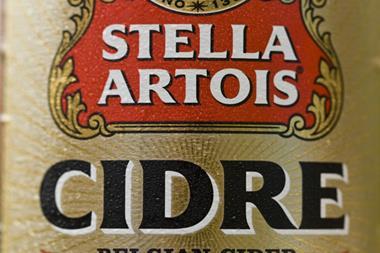What was that about the luck of the Irish?
No sooner is C&C hailing the return to growth of Magners than the world’s biggest brewer sets its sights on the UK cider market with a new offering pitched at the premium heartland dominated by Magners and arch-rival Bulmers.
An 4.5% abv cider, available in 568ml bottles and 440ml cans, the planned Easter launch of Stella Cidre broken exclusively by The Grocer on our website (thegrocer.co.uk) this week is a radical departure for AB InBev and marks the first time a leading beer or lager brand has crossed over into cider. The fact this is the UK off-trade’s biggest-selling lager by a country mile, with sales of £525m, makes the move more momentous still.
But, as St Patrick’s Day revellers hit the bottle (both in the name of drowning their sorrows and boosting the Irish cider’s sales), the reaction from cidermakers, rival brewers and branding agencies, has been mixed.
Some fear that Stella’s latest and most radical brand extension could be used by ABInBev to undercut the biggest cider players on price. Critics argue that this tactic was employed by ABInBev with its earlier Stella 4% lager launch.
Those fears may be assuaged by AB InBev president Stuart MacFarlane’s promise that Stella Cidre will be a premium-price product proposition.
“I don’t set the retail price,” he stressed, “but Stella Cidre will bring premium, craft, heritage and quality to the cider category the same qualities that brought us success in lager to accelerate cider growth, with the emphasis on premiumisation and delivering value sales more than volume.”
MacFarlane hopes to source drinkers of both core and premium ciders, but he also believes core lager drinkers will use Stella Cidre to enter cider for the first time, thereby growing the category.
The UK consumes over 50% of the world’s total cider, and growth in the past five years has been phenomenal, up 46%, according to Mintel, to 840 million litres.
But cider is still only a “very small part of the UK alcohol industry” at 7.9% [HMRC to September 2010], says Henry Chevallier, chairman of the National Association of Cider Makers, and he believes, from the cider industry perspective, ABInBev’s move is “a good thing.”
“It shows AB InBev’s confidence in the category. It is also reassuring there are a lot of smaller apple growers with a vested interest in the market being buoyant. And they’re coming in at the right end the premium end.”
Magners maker C&C also “welcomed the investment into the cider category”, while Thatchers MD Martin Thatcher added “imitation is the best form of flattery”.
MacFarlane believes Stella can restimulate sales of cider: with value up 7.7% and volume increasing 5.1% in 2010 [Nielsen MAT 2 October] compared with value and volume growth of 16.4% and 12.7% respectively the year before he predicts Stella’s arrival will double value growth to about 15%.
But product quality and AB InBev’s marketing might will count for nothing if consumers don’t get it, and some brand experts believe the cross-category leap is a “daring” move.
Anne-Cecile Bertrand, consultant at branding agency The Value Engineers, says “the UK market is really segmented: a beer can’t do wine, for example”. And any brand extensions where a beer has tried to outreach its area of expertise “have failed”, she adds, citing Guinness Enigma lager as a recent example.
She also believes the Stella brand has yet to fully recover its lost status. “You can only extend from a strong brand, and this is doubly true when you extend across the product type. They are trying to jump a very high fence.”
Allen Hogan, founder of Hogans cider, also questions whether the move will simply “cannibalise its already deteriorating lager business”, pointing out that sales of Stella Artois were down 0.7% to £525m [Nielsen MAT 2 October].
“The family architecture is a bit confused, with Stella Artois, Stella 4 and Stella Black,” adds Bertrand. Adding a cider might confuse things more, she claims. But she acknowledges that if AB InBev succeeds, it will set Stella up as a multi category product and have a “halo effect”.
MacFarlane is certainly confident. “In 20 years in the business, this is the most excited I’ve ever been. Stella Cidre will prove, once and for all, that Stella as a brand is right up there with other leading fmcg brands such as Coca-Cola.”
Stella through the ages
1958 Stella Artois launches in the UK and sells 2420 hectolitres
1976 Whitbread acquires the UK licence
1982-2006 ‘Reassuringly Expensive’ strapline helps Stella grow into the UK’s no1 premium lager brand
2007-08 ‘Wifebeater’ tag sees Stella lower abv to 5%, and launch Stella 4%, a lower-abv variant
2010 With UK off-trade sales of £525m, The Grocer crowns Stella the UK’s biggest alcoholic brand
2011 Stella Cidre launch announced



















1 Readers' comment